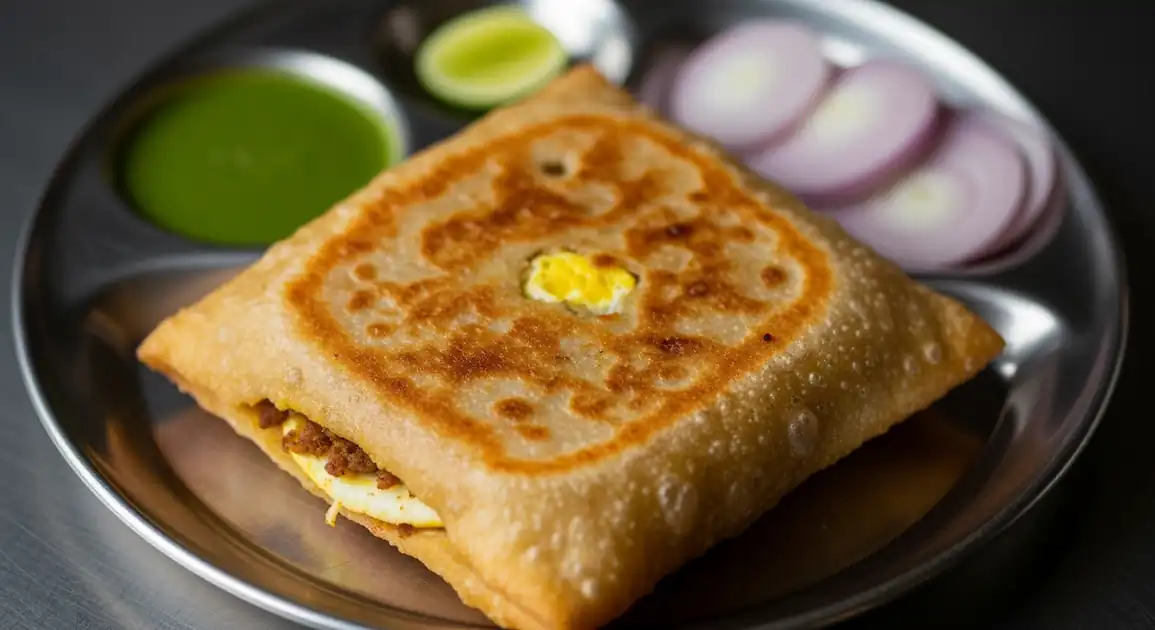Baida Roti
Baida Roti / Anda Roti

Description
Baida Roti is found in various parts of India, especially in cities with significant Mughlai culinary influence or bustling street food cultures like Mumbai, Delhi, Hyderabad, and Kolkata (where a similar dish called Mughlai Paratha exists). It's primarily known as a non-vegetarian street snack or restaurant item.
Dietary Information
Serving information
Serving style
Served hot, often cut into 4-6 pieces, on a plate (steel or disposable) with green chutney and raw onion rings or slices. Eaten with hands or a fork.
Quick facts
Primarily Evening and Late Night (approx. 6 PM - 2 AM), though some restaurants might offer it earlier.
Safety Tips
What to Look For
-
Cooked fresh to order on a hot griddle ('tawa').
Ensures the filling (especially egg and meat) is cooked thoroughly and the roti is served hot and crispy, minimizing bacterial risk.
-
Busy stall with high turnover.
Suggests ingredients are fresh and the vendor follows good practices that attract customers.
-
Clean preparation area and utensils.
Basic hygiene is crucial, especially when handling raw egg and meat mixtures.
-
Vendor uses separate hands/gloves for handling money and food.
Reduces risk of cross-contamination.
-
Roti is cooked until golden brown and slightly puffed.
Indicates it's likely cooked through. Avoid pale or soggy-looking rotis.
What to avoid
-
Pre-cooked Baida Rotis sitting on the counter.
Increased risk of bacterial growth as the filling cools. Always insist on freshly cooked.
-
Griddle ('tawa') is not sufficiently hot.
May result in undercooked filling and a greasy, soggy roti.
-
Visible signs of poor hygiene (dirty cloths, unclean surfaces, flies).
Increases the risk of foodborne illness significantly.
-
Fillings look discolored or smell off.
Indicates spoilage. Trust your senses.
Price information
Price range
Budget tips
- Street stalls offer the most competitive prices (60-150 INR).
- Restaurants and famous eateries like Bade Miya charge a premium (150-250 INR or more).
- Mutton versions might be slightly more expensive than chicken.
Value indicators
- Generous amount of filling.
- Crispy, non-greasy texture.
- Served piping hot off the tawa.
- Flavorful accompanying chutney.
Where to Find This Dish
Busy Market Areas
Found in bustling markets and commercial centers.
Crawford Market (Mumbai), Chandni Chowk (Delhi)
Evening, Late Night
Muslim-Dominated Neighborhoods
Often concentrated in areas known for traditional Mughlai/Muslim cuisine.
Mohammed Ali Road (Mumbai), Nizamuddin (Delhi), Charminar area (Hyderabad)
Evening, Late Night (especially during Ramadan)
Food Streets ('Khau Gallis')
Dedicated streets or lanes famous for diverse street food offerings.
Carter Road (Mumbai), VV Puram Food Street (Bangalore)
Evening, Late Night
Vendor Tips
- Specify your filling choice clearly (Chicken/Mutton).
- Observe the cooking process to ensure it's fresh and thorough.
- Don't hesitate to ask for extra chutney or onions if needed.
How to Order
Regional Variations
-
Chicken Baida Roti
(Chicken Baida Roti)
Filled with spiced minced chicken and egg. A very popular choice.
-
Mutton Baida Roti
(Mutton Baida Roti)
Filled with spiced minced mutton (goat meat) and egg. Often considered the traditional version.
-
Vegetarian Baida Roti
(Veg Baida Roti)
A less common variation filled with spiced paneer (Indian cottage cheese) or mixed vegetables, still typically includes egg unless specified otherwise (which would be very unusual).
-
Anda Roti (Egg Only)
(Anda Roti / Plain Baida Roti)
Sometimes available, this version contains only spiced egg and onions, without the minced meat.
Cultural context
History
Baida Roti's origins are often linked to Mughlai cuisine, adapted for the bustling street food culture of cities like Mumbai. It evolved as a hearty, portable, and flavorful meal or snack. Stalls in areas like Mohammed Ali Road in Mumbai have served it for generations, making it a culinary landmark, especially during Ramadan evenings and late nights.
Local significance
A hearty and flavorful snack/meal, representing the fusion of Mughlai flavors with convenient street food preparation. It's a staple late-night indulgence in cities like Mumbai.
Eating customs
- Typically eaten hot as soon as served.
- Use the chutney and onions to complement the richness of the roti.
- Often shared among friends.